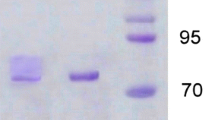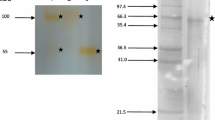Abstract
Two laccase isoenzymes were purified and characterized from the basidiomycete Coriolopsis rigida during transformation of the water-soluble fraction of “alpeorujo” (WSFA), a solid residue derived from the olive oil production containing high levels of toxic compounds. Zymogram assays of laccases secreted by the fungus growing on WSFA and WSFA supplemented with glucose showed two bands with isoelectric points of 3.3 and 3.4. The kinetic studies of the two purified isoenzymes showed similar affinity on 2,6-dimethoxyphenol and 2,2′-azinobis-(3-ethylbenzthiazoline-6-sulfonic acid), used as phenolic and non-phenolic model substrate, respectively. The molecular mass of both proteins was 66 kDa with 9% N-linked carbohydrate. Physico-chemical properties of the purified laccases from media containing WSFA were similar to those obtained from medium with glucose as the main carbon source. In-vitro studies performed with the purified laccases revealed a 42% phenol reduction of WSFA, as well as changes in the molecular mass distribution. These findings indicate that these laccases are involved in the process of transformation, via polymerization by the oxidation of phenolic compounds present in WSFA. A single laccase gene, containing an open reading frame of 1,488 bp, was obtained in PCR amplifications performed with cDNA extracted from mycelia grown on WSFA. The product of the gene shares 90% identity (95% similarity) with a laccase from Trametes trogii and 89% identity (95% similarity) with a laccase from Coriolopsis gallica. This is the first report on purification and molecular characterization of laccases directly involved in the transformation of olive oil residues.





Similar content being viewed by others
References
Altschul SF, Madden TL, Schaffer AA, Zhang J, Zhang Z, Miller W, Lipman DJ (1997) Gapped BLAST and PSI-BLAST: a new generation of protein database search programs. Nucleic Acids Res 25:3389–3402
Aranda E, Sampedro I, Ocampo JA, García-Romera I (2006) Phenolic removal of olive-mill dry residues by laccase activity of white-rot fungi and its impact on tomato plant growth. Int Biodeter Biodegr 58:176–179
Aranda E, García-Romera I, Ocampo JA, Carbone V, Mari A, Malorni A, Sannino F, De Martino A, Capasso R (2007) Chemical characterization and effects on Lepidium sativum of the native and bioremediated components of dry olive mill residue. Chemosphere 69:229–239
Baldrian P (2004) Purification and characterization of laccase from the white-rot fungus Daedalea quercina and decolorization of synthetic dyes by the enzyme. Appl Microbiol Biotechnol 63:560–563
Baldrian P (2006) Fungal laccases: occurrences and properties. FEMS Microbiol Rev 30:215–242
Berrio J, Plou FJ, Ballesteros A, Martínez AT, Martínez MJ (2007) Immobilization of Pycnoporus coccineus laccase on Eupergit C: stabilization and treatment of olive oil mill wastewaters. Biocatal Biotransform 25:130–134
Bonanomi G, Sicurezza MG, Caporaso S, Esposito A, Mazzoleni S (2006) Phytotoxicity dynamics of decaying plant materials. New Phytol 169:571–578
Capasso R, Evidente A, Schivo I, Orru G, Marciallis MA, Cristinzo G (1995) Antibacterial polyphenols from olive oil mill waste waters. J Appl Bacteriol 79:393–398
Capelari M, Zadrazil F (1997) Lignin degradation and in-vitro digestibility of wheat straw treated with Brazilian tropical species of white rot fungi. Folia Microbiol 42:481–487
Colao MC, Garzillo AM, Buonocore V, Schiesser A, Ruzzi M (2003) Primary structure and transcription analysis of a laccase-encoding gene from the basidiomycete Trametes trogii. Appl Microbiol Biotechnol 63:153–158
D'Annibale A, Stazi SR, Vinciguerra V, Sermanni GG (2000) Oxirane-immobilized Lentinula edodes laccase: stability and phenolics removal efficiency in olive mill wastewater. J Biotechnol 77:265–273
Dantán-González E, Vite-Vallejo O, Martínez-Anaya C, Méndez-Sánchez M, González MC, Palomares LA, Folch-Mallol J (2008) Production of two novel laccase isoforms by a thermotolerant strain of Pycnoporus sanguineus isolated from an oil-polluted tropical habitat. Int Microbiol 11:163–169
de la Rubia T, Lucas M, Martínez J (2008) Controversial role of fungal laccases in decreasing the antibacterial effect of olive mill waste-waters. Bioresource Technol 99:1018–1025
Dekker RFH, Barbosa AM, Giese EC, Godoy SDS, Covizzi LG (2007) Influence of nutrients on enhancing laccase production by Botryosphaeria rhodina MAMB-05. Int Microbiol 10:177–185
Dias AA, Bezerra RM, Pereira AN (2004) Activity and elution profile of laccase during biological decolorization and dephenolization of olive mill wastewater. Bioresource Technol 92:7–13
Eggert C, Temp U, Eriksson KEL (1997) Laccase is essential for lignin degradation by the white-rot fungus Pycnoporus cinnabarinus. FEBS Lett 407:89–92
Galhaup C, Wagner H, Hinterstoisser B, Haltrich D (2002) Increased production of laccase by the wood-degrading basidiomycete Trametes pubescens. Enzyme Microb Technol 30:529–536
Gómez J, Solar DR, Pazos M, Sanroman MA (2006) Applicability of Coriolopsis rigida for biodegradation of polycyclic aromatic hydrocarbons. Biotechnol Lett 28:1013–1017
Hong YZ, Zhou HM, Tu XM, Li JF, Xiao YZ (2007) Cloning of a laccase gene from a novel basidiomycete Trametes sp. 420 and its heterologous expression in Pichia pastoris. Curr Microbiol 54:260–265
Jaouani A, Guillén F, Penninckx MJ, Martínez AT, Martínez MJ (2005) Role of Pycnoporus coccineus laccase in the degradation of aromatic compounds in olive oil mill wastewater. Enzyme Microb Technol 36:478–486
Kotsou M, Mari L, Lasaridi K, Chatzipavlidis L, Balis C, Kyriacou A (2004) The effect of olive oil mill wastewater (OMW) on soil microbial communities and suppressiveness against Rhizoctonia solani. Appl Soil Ecol 26:113–121
Leontievsky AA, Vares T, Lankinen P, Shergill JK, Pozdnyakova NN, Myasoedova NM, Kalkkinen N, Golovleva LA, Cammack R, Thurston CF, Hatakka A (1997) Blue and yellow laccases of ligninolytic fungi. FEMS Microbiol Lett 156:9–14
Mansur M, Suárez T, González AE (1998) Differential gene expression in the laccase gene family from basidiomycete I-62 (CECT 20197). Appl Environ Microbiol 64:771–774
Mayer AM, Staples RC (2002) Laccase: new functions for an old enzyme. Phytochemistry 60:551–565
Michniewicz A, Ullrich R, Ledakowicz S, Hofrichter M (2006) The white-rot fungus Cerrena unicolor strain 137 produces two laccase isoforms with different physico-chemical and catalytic properties. Appl Microbiol Biot 69:682–688
Minussi RC, Miranda MA, Silva JA, Ferreira CV, Aoyama H, Marangoni S, Rotilio D, Pastore GM, Duran N (2007) Purification, characterization and application of laccase from Trametes versicolor for colour and phenolic removal of olive mill wastewater in the presence of 1-hydroxybenzotriazole. African J Biotechnol 6:1248–1254
Muñoz C, Guillén F, Martínez AT, Martínez MJ (1997) Induction and characterization of laccase in the ligninolytic fungus Pleurotus eryngii. Curr Microbiol 34:1–5
Petrov N, Budinova T, Razvigorova M, Parra J, Galiatsatou P (2008) Conversion of olive wastes to volatiles and carbon adsorbents. Biomass Bioenerg 32:1303–1310
Quaratino D, Federici F, Petruccioli M, Fenice M, D'Annibale A (2007) Production, purification and partial characterisation of a novel laccase from the white-rot fungus Panus tigrinus CBS 577.79. Antonie van Leeuwenhoek 91:57–69
Quaratino D, Ciaffi M, Federici E, D'Annibale A (2008) Response surface methodology study of laccase production in Panus tigrinus liquid cultures. Biochem Eng J 39:236–245
Robles A, Lucas R, Alvárez de Cienfuegos G, Gálvez A (2000) Phenol-oxidase (laccase) activity in strains of the hyphomycete Chalara paradoxa isolated from olive mill wastewater disposal ponds. Enzyme Microb Tech 26:484–490
Ruiz-Dueñas FJ, Martínez MJ, Martínez AT (1999) Molecular characterization of a novel peroxidase isolated from the ligninolytic fungus Pleurotus eryngii. Mol Microbiol 31:223–236
Sampedro I, Romero C, Ocampo JA, Brenes M, Garcia I (2004) Removal of monomeric phenols in dry mill olive residue by saprobic fungi. J Agr Food Chem 52:4487–4492
Sampedro I, D'Annibale A, Ocampo JA, Stazi SR, García-Romera I (2005) Bioconversion of olive-mill dry residue by Fusarium lateritium and subsequent impact on its phytotoxicity. Chemosphere 60:1393–1400
Sampedro I, Marinari S, D'Annibale A, Grego S, Ocampo JA, García-Romera I (2007) Organic matter evolution and partial detoxification in two-phase olive mill waste colonized by white-rot fungi. Int Biodeter Biodegr 60:116–125
Sánchez-López MI, Vanhulle SF, Mertens V, Guerra G, Figueroa SH, Decock C, Corbisier AM, Penninckx MJ (2008) Autochthonous white rot fungi from the tropical forest: potential of Cuban strains for dyes and textile industrial effluents decolourisation. Afr J Biotechnol 7:1983–1990
Saparrat MCN, Guillén F (2005) Ligninolytic ability and potential biotechnology applications of the South American fungus Pleurotus laciniatocrenatus. Folia Microbiol 50:155–160
Saparrat MCN, Guillén F, Arambarri AM, Martínez AT, Martínez MJ (2002) Induction, isolation, and characterization of two laccases from the white-rot basidiomycete Coriolopsis rigida. Appl Environ Microb 68:1534–1540
Saparrat MCN, Mocchiutti P, Liggieri CS, Aulicino MB, Caffini NO, Balatti PA, Martínez MJ (2008) Ligninolytic enzyme ability and potential biotechnology applications of the white-rot fungus Grammothele subargentea LPSC no. 436 strain. Process Biochem 43:368–375
Saparrat MCN, Jurado M, Díaz R, Romera IG, Martinez MJ (2010) Transformation of the water soluble fraction from “alpeorujo” by Coriolopsis rigida: the role of laccase in the process and its impact on Azospirillum brasiliense survival. Chemosphere 78:72–76
Sarkanen S, Teller DC, Abramowski E, Mccarthy JL (1982) Kraft lignin component conformation and associated complex configuration in aqueous alkaline-solution. Macromolecules 15:1098–1104
Schoemaker HE, Tuor U, Muheim A, Schmidt HWH, Leisola MSA (1991) White-rot degradation of lignin and xenobiotics. In: Betts WB (ed) Biodegradation: natural and synthetic materials. Springer-Verlag, London, pp 157–174
Singleton V, Rossi JA (1965) Colorimetry of total phenolics with phosphomolybdic-phosphotungstic acid reagents. Am J Enol Viticult 16:144–158
Thurston CF (1994) The structure and function of fungal laccases. Microbiology 140:19–26
Tomati U, Galli E, Dilena G, Buffone R (1991) Induction of laccase in Pleurotus ostreatus mycelium grown in olive oil waste-waters. Agrochimica 35:275–279
Tsioulpas A, Dimou D, Iconomou D, Aggelis G (2002) Phenolic removal in olive oil mill wastewater by strains of Pleurotus spp. in respect to their phenol oxidase (laccase) activity. Bioresource Technol 84:251–257
Vlyssides AG, Loizidou M, Gimouhopoulos K, Zorpas A (1998) Olive oil processing wastes production and their characteristics in relation to olive oil extraction methods. Fresen Environ Bull 7:308–313
Acknowledgements
This work was supported by the Spanish projects S-0505/AMB0100, A/019945/08, AGL2008-00572/AGR and P06-AGR-01906. R. Díaz thanks the Spanish Ministry for mobility fellowship to the Centro de Investigaciones Biológicas (CSIC), Madrid, Spain.
Author information
Authors and Affiliations
Corresponding author
Rights and permissions
About this article
Cite this article
Díaz, R., Saparrat, M.C.N., Jurado, M. et al. Biochemical and molecular characterization of Coriolopsis rigida laccases involved in transformation of the solid waste from olive oil production. Appl Microbiol Biotechnol 88, 133–142 (2010). https://doi.org/10.1007/s00253-010-2723-z
Received:
Revised:
Accepted:
Published:
Issue Date:
DOI: https://doi.org/10.1007/s00253-010-2723-z




